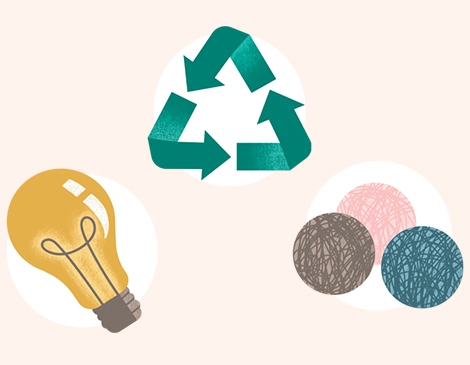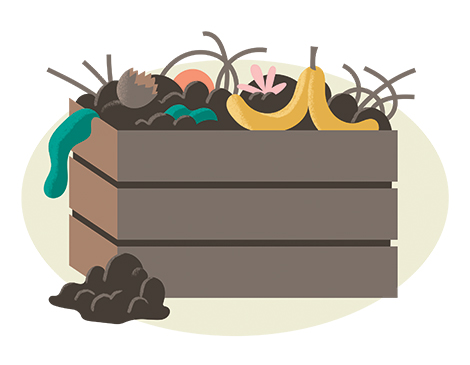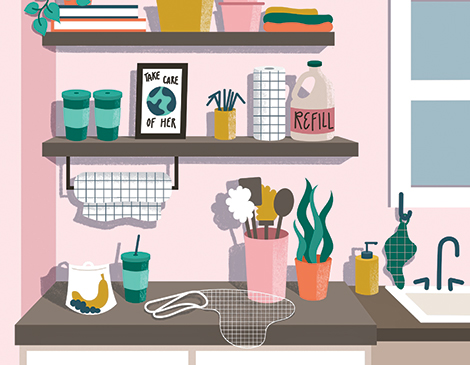Plastic. It’s hard to escape, especially in our everyday lives. However, integrating small habits such as reusing home items can make a big difference.
“Tossed plastic goes away. It doesn’t disappear,” says Rachel Regula, who owns Little Spark Refill Shop in Rocky River, which offers an alternative to single-use plastic. “There’s a ton of plastic in our gorgeous lake, the lake we use for boating, fishing, even our drinking water. We need to shift our thinking.”
Refill shops like this are hoping to push that shift. Here’s how it works: bring a container — any container — to refill it with laundry soap, body lotion, dishwashing liquid and more. Shop staff weigh your empty container; you pay for the refreshed contents. Use. Repeat.
Since opening originally in Lakewood last October, Regula’s shop has refilled more than 5,640 plastic bottles — bottles that had a job and can still do that job, and are not in a landfill. That number continues to grow weekly.
Other every-day items can be switched out as well. Stop using two or three plastic straws per day. Instead, buy a pack of reusable metal straws for that daily coffee run. Instead of a dish sponge that will be thrown out eventually, a wooden dish scrubber lasts longer. You could even opt for a shampoo bar that uses zero packaging, or a compostable cling wrap for packing leftovers.
While these changes seem miniscule, they add up in the end. “It takes plastic 400 years to go away,” Regula says.
Ultimately, the goal is to make trips to a refill shop or station an errand as common as grocery shopping. “We’re here to walk you through creating a more sustainable home, and use products that are good for you and the environment,” Regula says.

Going Greener: Rachel Regula, owner of Little Spark Refill Shop gives us three simple eco-friendly steps for the home you might not know about.
Home Green Home
Don’t know how much electricity your house is using? Schedule an energy audit. This will give you an overview of where energy can be saved. “We had an auditor from the Illuminating Co.,” Regula says. “They changed our bulbs to LED for us. They offered us a rebate on a smart thermostat. It was so simple and effective.”
Laundry Day
Although seemingly innocent, dryer sheets can create more waste and even harm your dryer in the process. “There are no federal regulations regarding what goes into them,” says Regula. Try line-drying items or using reusable wool balls instead in order to save on energy and avoid dryer sheets.“They last for a thousand dry cycles.”
Recycle Better
When it comes to trash day, take that extra step and make sure those hard-to-recycle items get squared away. Services such as TerraCycle specialize in all things most recycling centers won’t touch. “They take disposable contact lenses and blister packs, old plastic pens, used food storage containers,” Regula says.

Composting 101: Forty percent of purchased edible food ends up in landfills, so composting has proven to be an eco-friendly solution. Here’s three things to know.
Food Cycle
First, get a trusty bucket. Second, make sure you’re setting aside the right type of waste to be composted. “We can compost anything that was once edible,” says Daniel Brown, co-founder of Rust Belt Riders, a local composting company. Most home composting piles are a combination of fruit and vegetable scraps, coffee grounds and eggshells. But not everything can go in there. Items such as meat, dairy and bones are typically not used for a house pile.
Balancing Act
To ensure a thriving compost pile, balance is key. The pile needs to be one part nitrogen-based materials such as grass clippings, veggies and fruits and two parts carbon-based materials such as wood chips, newspaper and straw. “The best intentions can lead to a pile with too much waste. That’s too much nitrogen and not enough carbon,” says Brown. Then, wetting the pile with a watering hose just a bit ensures an even breakdown between the chemicals.
Temperature Check
After two or three days, the pile will take on a life of its own and become hot to the touch in the middle. Get a thermometer to check if it’s getting to the right temperature — above 131 degrees for at least 48 hours. If it falls too low, get a gardening fork and turn the materials around and check again in 24 hours. “Piles that are too dry, too inert don’t reach temperatures required for effective decomposition,” says Brown.




